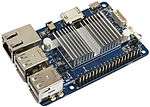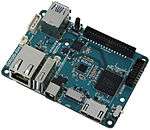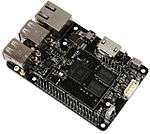ODROID
|
ODROID-C2 board | |
| Release date | February 2016 |
|---|---|
| Introductory price | US$40 |
| Operating system | Linux: (Ubuntu, Arch Linux), Android – Directboot Linux, Kodi, etc. with dietpi |
| System-on-chip used | Amlogic S905 |
| CPU | 2.0 GHz 64-bit quad-core ARM Cortex-A53 |
| Memory | 2 GB LPDDR3 RAM at 912 MHz |
| Storage | MicroSDHC slot, eMMC module socket |
| Graphics | Mali-450 MP3 |
| Connectivity | 4× USB 2.0, micro-USB OTG, HDMI 2.0, Gigabit Ethernet (8P8C), Infrared, 40× GPIO ports |
| Power | 0.8–2 A (4–10 W) |
The ODROID is a series of single-board computers and tablet computers created by Hardkernel Co., Ltd., an open-source hardware company located in South Korea. Even though the name ‘ODROID’ is a portmanteau of ‘open’ + ‘Android’,[1] the hardware isn't actually open because some parts of the design are retained by the company.[2] Many ODROID systems are capable of running not only Android, but also regular Linux distributions.
Hardware
Several models of ODROID's have been released by Hardkernel. The first generation was released in 2009, followed by higher specification models. Current boards are priced US$32 for the C1+, US$40 for the C2 and US$74 for the XU4.
C models feature a Amlogic system on a chip (SoC), while XU models feature a Exynos SoC. Both include an ARM central processing unit (CPU) and an on chip graphics processing unit (GPU). CPU speed ranges from 1.5 GHz to 2.0 GHz, a board memory range from 1 GB RAM to 2 GB RAM. Secure Digital SD cards are used to store the operating system and program memory in either the SDHC or MicroSDHC sizes. Most boards have between three and five mixed USB 2.0 or 3.0 slots, HDMI output, and a 3.5 mm jack. Lower level output is provided by a number of general-purpose input/output (GPIO) pins which support common protocols like I²C. Current models have an Gigabit Ethernet (8P8C) port and eMMC module socket.[3]
Specifications
| Name | Image | Year | CPU | GPU | RAM | Storage | USB | Video out | Audio in | Audio out | Network | Peripherals | Power source | PCB size | OS |
|---|---|---|---|---|---|---|---|---|---|---|---|---|---|---|---|
| ODROID | 2009 | Samsung S5PC100 833 MHz, Cortex-A8 | 512 MB DDR2 | 2 GB microSD,
8 GB SDHC |
USB, battery charging, serial port for system monitoring | standard type-C HDTV | Marvell 8686 & CSR BC4-ROM | 3-axis acceleration sensor | Android v1.5 | ||||||
| ODROID-U2 | 2012[4] | 1.7 GHz Exynos 4412 | Mali-400 MP4 quad-core 440 MHz | 2 GB DDR2 | microSD card slot, eMMC module socket | 2 × USB A Host,
1 × ADB/Mass storage (micro USB) |
Micro HDMI connector | 3.5 mm jack and HDMI | 10/100 Ethernet (8P8C) | 5 volt @ 2 A | 48 × 52 mm | Android, Ubuntu, Arch Linux[5] | |||
| ODROID-X2 | 2012 | SD card slot, eMMC module socket | 6 × USB A Host,
1 × ADB/Mass storage (Micro USB) |
Micro HDMI connector,
RGB 24-bit LCD interface port |
Mic | expansion ports for GPIO, UART, I²C, SPI bus, ADC and LCD | 90 × 94 mm | Android, Ubuntu | |||||||
| ODROID-U3 |  |
2014 | 1.7 GHz Exynos 4412 Prime | Mali-400 MP4 quad-core 533 MHz | 2 GB LPDDR2 PoP (Package on Package) | microSD card slot, eMMC module socket | 3 × USB 2.0 A Host
1 x USB 2.0 ADB/Mass Storage (Micro USB) |
Micro HDMI connector | 3.5 mm jack and HDMI | 10/100 Ethernet (8P8C) | expansion ports for GPIO, UART, I²C, SPI bus, PWM
ADC and LCD |
5 volt @ 2 A | 83 × 48 mm | Android, Ubuntu, Arch Linux | |
| ODROID-XU | 2013 | Exynos 5410 Octa big.LITTLE ARM Cortex-A15 @ 1.6 GHz quad-core and ARM Cortex-A7 @ 1.2 GHz quad-core CPUs | PowerVR SGX544MP3 (OpenGL ES 2.0, OpenGL ES 1.1, and OpenCL 1.1 EP) | 2 GB LPDDR3 PoP (Package on Package) | microSD card slot, eMMC 4.5 module socket | 4 × USB 2.0 A Host
1 x USB 3.0 Host, 1 x USB 3.0 OTG |
Micro HDMI connector 1.4a output Type-D, | 3.5 mm jack and HDMI | 10/100 Ethernet (8P8C) | expansion ports for GPIO, UART, I²C, SPI bus, PWM
ADC and LCD |
5 volt @ 4 A | 94 × 70 × 18 mm | Android, Ubuntu | ||
| ODROID-XU3/XU3-Lite |  |
2014 | Exynos 5422 Octa big.LITTLE ARM Cortex-A15 @ 2.0 GHz (Lite @ 1.8 GHz) quad-core and Cortex-A7 quad-core CPUs | Mali-T628 MP6 (OpenGL ES 3.0/2.0/1.1 and OpenCL 1.1 Full profile) | 2 GB LPDDR3 RAM at 933 MHz (14.9 GB/s memory bandwidth) PoP stacked | microSD card slot, eMMC5.0 HS400 Flash Storage | 4 × USB 2.0 A Host
1 x USB 3.0 Host, 1 x USB 3.0 OTG |
Micro HDMI connector 1.4a output Type-D,
Integrated power consumption monitoring tool |
3.5 mm jack and HDMI | 10/100 Ethernet (8P8C) | expansion ports for GPIO, UART, I²C, SPI bus, PWM
ADC and LCD |
5 volt @ 4 A | 94 × 70 × 18 mm | Android, Ubuntu | |
| ODROID-W[7] (discontinued) (W for Wearable computer) |
2014 | Broadcom BCM2835 ARM11 @ 700 MHz | Broadcom VideoCore IV | 512 MB DDR2 SDRAM | microSD card slot, eMMC module socket | 1 x USB 2.0 Host | Micro HDMI connector 1.4a output Type-D | expansion ports for GPIO, MIPI input for camera, PWM ADC and real-time clock | 5 V input from Micro-USB socket | 60 x 36 mm | |||||
| ODROID-C1[8] |  |
2014 | Amlogic S805, 4× Cortex-A5 @ 1.5 GHz | Mali-450 MP2 | 1 GB DDR3 SDRAM | microSD card slot, eMMC module socket | 4× USB 2.0 Host, 1× USB 2.0 OTG | Micro HDMI connector Type-D | — | — | 10/100/1000 Ethernet (8P8C) | expansion ports for console UART, IR receiver, GPIO, I²C, SPI, ADC | 5 V DC input | 85 × 56 mm | Linux, Android |
| ODROID-C1+[9] |  |
2015 | standard HDMI connector Type-A | 5 V input from Micro-USB socket | |||||||||||
| ODROID-XU4[10] |  |
2015 | Exynos 5422 Octa big.LITTLE ARM Cortex-A15 @ 2.0 GHz quad-core and Cortex-A7 quad-core CPUs | Mali-T628 MP6 (OpenGL ES 3.0/2.0/1.1 and OpenCL 1.1 Full profile) | 2 GB LPDDR3 RAM at 933 MHz (14.9 GB/s memory bandwidth) PoP stacked | microSD card slot, eMMC5.0 HS400 Flash Storage | 1 × USB 2.0 A Host
2 x USB 3.0 Host |
HDMI connector 1.4a output Type-A | HDMI | 10/100/1000 Ethernet (8P8C) | expansion ports for GPIO, UART, I²C, I²S, SPI bus, PWM
ADC |
5 volt @ 4 A | 83 x 59 x 18 mm | Linux (Ubuntu, Kali Linux[11]), Android | |
| ODROID-C2[12] |  |
2016 | Amlogic S905, Cortex-A53 (ARMv8 64bit) quad-core | Mali-450 MP3 (3 Pixel +2 Vertex Shader) triple-core | 2 GB DDR3 SDRAM at 912 MHz | microSD card slot, eMMC module socket | 4× USB 2.0 Host | Type-A HDMI 2.0 4K/60 Hz | — | HDMI | 10/100/1000 Ethernet (8P8C) | expansion ports for console UART, IR receiver, 40× GPIO, I²C, ADC | 5 V2A DC input | 85 × 56 mm | Linux: (Ubuntu[13]Arch Linux[14]), Android[15]—Directboot Linux, Kodi, etc. with dietpi[16] |
| Name | Image | Year | CPU | GPU | RAM | Storage | USB | Video out | Audio in | Audio out | Network | Peripherals | Power source | PCB size | OS |
Software
Operating systems
- Android: Odroid C1/C1+/C0,[17] C2,[18] XU3/XU4[19]
- Desktop-style linux-based operating systems:
- Debian
- Arch Linux ARM: Odroid C1,[23] C2,[14] XU3,[24] XU4
- Fedora
- Void Linux: Odroid U2/U3[25]
- Media center operating systems:
- Kodi (formerly XBMC)
- Libreelec[26] : Odroid C2
- Audio operating systems:
- Retrogaming operating systems:
- Not Linux-based operating systems:
- NetBSD: Odroid C1/C1+[33]
- Genode OS Framework (with the base-hw kernel): Odroid XU[34]
References
- ↑ "ODROID-X-Q: Project Info, History of ODROID". Retrieved 2014-05-08.
The ODROID means Open + Android.
- ↑ "ODROID-U2/U schematics.". Retrieved 2014-05-08.
[Note] 3. We don't supply/sell any PCB design file or Gerber file. Please don't ask about it.
- ↑ http://www.mikronauts.com/hardkernel/hardkernel-odroid-xu4-review/
- ↑ http://com.odroid.com/sigong/blog/blog_list.php?bid=&tag=&page=6&page=7
- ↑ http://archlinuxarm.org/platforms/armv7/samsung/odroid-u2
- ↑ http://archlinuxarm.org/platforms/armv7/samsung/odroid-u3
- ↑ http://www.hardkernel.com/main/products/prdt_info.php?g_code=G140610189490
- ↑ http://www.hardkernel.com/main/products/prdt_info.php?g_code=G141578608433
- ↑ http://www.hardkernel.com/main/products/prdt_info.php?g_code=G141578608433
- ↑ http://www.hardkernel.com/main/products/prdt_info.php?g_code=G143452239825
- 1 2 "Kali Linux for Odroid XU3/XU4". docs.kali.org. Retrieved 2016-10-12.
- ↑ http://odroid.com/dokuwiki/doku.php?id=en:c2_hardware
- 1 2 "Ubuntu for Odroid C2". odroid.com. Retrieved 2016-10-12.
- 1 2 "Arch Linux Arm for Odroid C2". archlinuxarm.org. Retrieved 2016-10-12.
- ↑ "Android for Odroid C2". odroid.com. Retrieved 2016-11-30.
- ↑ https://github.com/Fourdee/DietPi
- ↑ "Android for Odroid C1/C1+/C0". odroid.com. Retrieved 2016-10-12.
- ↑ "Android for Odroid C2". odroid.com. Retrieved 2016-10-12.
- ↑ "Android for Odroid XU3/XU4". odroid.com. Retrieved 2016-10-12.
- ↑ "Ubuntu for Odroid C1/C1+/C0". odroid.com. Retrieved 2016-10-12.
- ↑ "Ubuntu for Odroid XU3/XU4". odroid.com. Retrieved 2016-10-12.
- ↑ "Kali Linux for Odroid C1". docs.kali.org. Retrieved 2016-10-12.
- ↑ "Arch Linux Arm for Odroid C1". archlinuxarm.org. Retrieved 2016-10-12.
- ↑ "Arch Linux Arm for Odroid XU3". archlinuxarm.org. Retrieved 2016-10-12.
- ↑ "Enter the void - Downloads". www.voidlinux.eu. Retrieved 2016-10-28.
- ↑ "LibreELEC – Media center OS". libreelec.tv. Retrieved 2016-10-12.
- ↑ "Volumio - Audio OS". Volumio. Retrieved 2016-10-12.
- ↑ "RuneAudio - Audio OS". RuneAudio. Retrieved 2016-10-12.
- ↑ "RetroPie - Retrogaming OS". RetroPie. Retrieved 2016-10-12.
- ↑ "Rétropie for Odroid C1/C1+". GitHub. Retrieved 2016-10-12.
- ↑ "Happi game center - Retrogaming OS". happi-game-center.com. Retrieved 2016-10-12.
- ↑ "Lakka - Retrogaming OS". www.lakka.tv. Retrieved 2016-10-12.
- ↑ "NetBSD/evbarm". wiki.netbsd.org. Retrieved 2016-10-28.
- ↑ "How to use Genode directly on hardware". genode.org. Retrieved 2016-10-28.
